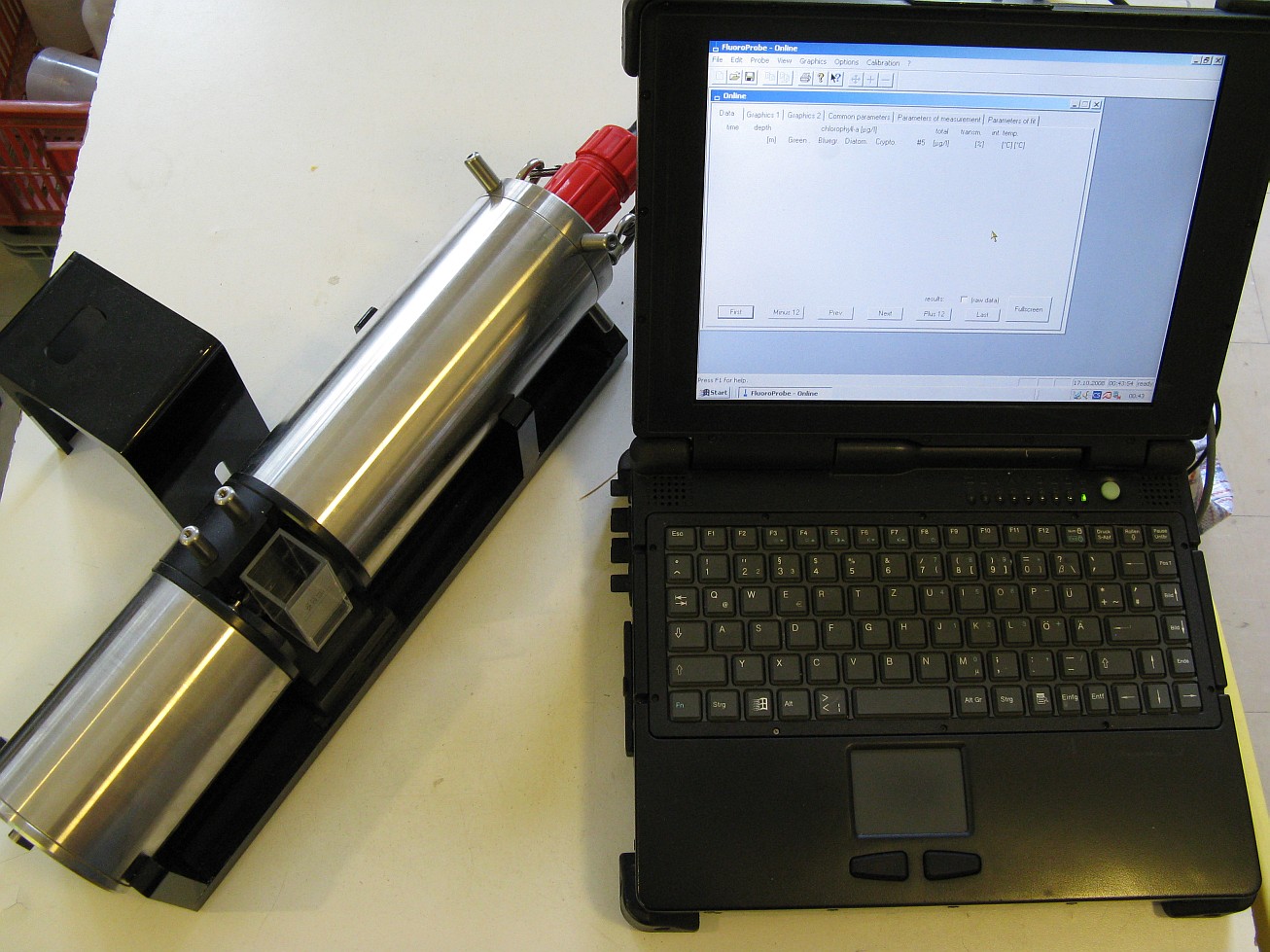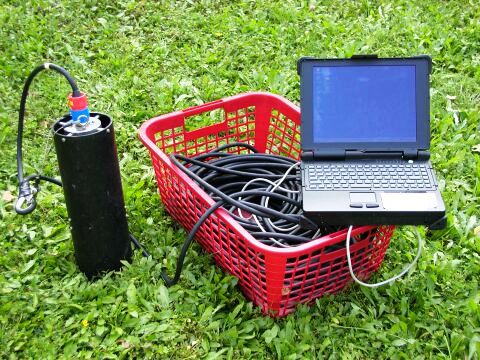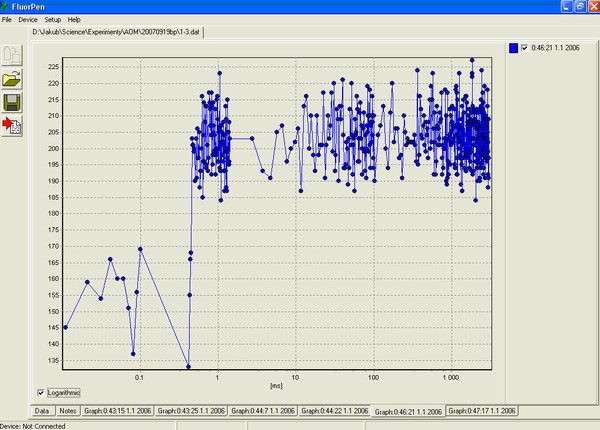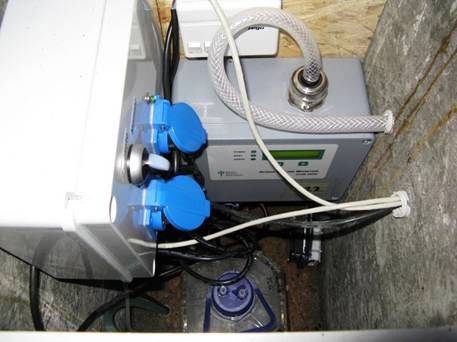Measurement of the fluorescence of photosynthetic pigments
Method principle
Photoautotrophic as well as other organisms need energy for the production of organic compounds. Photoautotrophs employ the energy of light, which they absorb, however absorbed light is not entirely utilized for photochemical reactions. Part of the energy is dissipated as heat and another one is emitted as fluorescence. Fluorescence is a physical phenomenon in which the absorption of light photons triggers in the molecule of fluorescent compound an emission of photons with longer (less energetic) wavelength. Measurement of chlorophyll fluorescence may be used for the indirect quantification of phytoplankton in samples from an aquatic environment. Moreover, the chlorophyll fluorescence changes in the time in relation to photosynthetic activity and could be used for the characterization of the status of photosynthetic apparatus in assessed algae or cyanobacteria.
Photosystem-II (PSII) of all photoautotrophic organisms is created by chlorophyll-a and other accessorial pigments (chlorophyll-b, phycocyanine, phycoerythrine, fucoxantine, peridinine etc.) which help to absorb the energy of light and pass it to chlorophyll-a. Each of these pigments is specific for some group of phytoplankton and they differ in the ability to absorb different wavelengths of visible light. Based on the presence of the pigments, photoautotrophic organisms may be categorized to following groups: "blue" (cyanobacteria), "green" (green algae), "brown" (bacillariophytes - diatoms, dinophytes), "red" (rhodophytes) and "mixed" (cryptophytes). Due to the energy transfer, excitation by a light of appropriate wavelength triggers a fluorescence emission from chlorophyll-a molecule. Some of other photosynthetic pigments (e.g. phycocyanines) are fluorescent themselves. In case of an appropriate configuration of measuring instruments, pigment fluorescence may serve as an endpoint for the determination of total chlorophyll-a concentration and provides information about the presence of various groups of phytoplankton in measured sample. When the induced chlorophyll fluorescence technique is applied, even some information about physiological status of the phytoplankton, and especially about its photosynthetic activity can be obtained. Main advantage of fluorescence measurement is easiness and non-destructiveness of the method. Measurement of fluorescence can be done repeatedly on the same sample not only in a laboratory conditions, but also in situ.


FluoroProbe, BenthoFluor, BenthoTorch
At our department three kinds of fluorescence probes from bbe Moldaenke GmBH, Kiel, Germany) are used: submersible probe FluoroProbe for measurements in water column and probes BenthoFluor and BenthoTorch for measurements on surfaces. All these “fluorometric” probes use LED diodes of various wavelengths as excitation light sources (in case of FluoroProbe e.g. 370 nm, 470 nm, 525 nm, 570 nm, 590 nm and 610 nm respectively). Chlorophyll fluorescence emission is measured at fixed wavelength of 680 nm. Based on their excitation spectra, following phytoplankton groups can be discriminated in the measured sample: Chlorophyceae (green algae), Cyanophyceae (cyanobacteria), Bacillariophyceae (diatoms) together with Dinophyceae and Cryptophyceae. The amount of phytoplankton biomass is expressed as chlorophyll-a concentration (in µg per ml of sample). Detection limit as stated by manufacturer is 1 µg L-1 and according to our experience, upper limit for the detection, especially when cyanobacteria dominate in the measured sample, is approximately 50 µg L-1 (when higher concentration of chlorophyll-a in the sample is expected, it is necessary to dilute the sample appropriately). FluoroProbe may be used in the laboratory (with the cuvette adapter) as well as in situ in entire profile of a dam (up to the depth of 100 meters depending on the length of measuring cable) or a stream. Probes BenthoFluor and BenthoTorch enable the determination of chlorophyll-a concentration in benthic mats – photoautotrophic communities on various surfaces, like sediments, stones or man-made materials both below and above water surface.
Spectro(fluoro)metric microplate readers Tecan Sunrise and Genios
These machines are typical spectrophotometers from TECAN (Maennedorf, Switzerland) with adjustable light wavelengths, which are able to measure optical values like absorbance and transmittance (Sunrise) and/or fluorescence and luminescence (Genios). Both spectrophotometers are adapted for simultaneous measurement of high number of samples in microplates (96-well plates).
Fluorometers FluorCam 690, AquaPenAP100-C, FL3500 FAST
These so-called “fluorometers” (all from Photon Systems Instruments, Brno, Czech Republic) are designed for measurements of induced chlorophyll fluorescence in relation to physiological state of phytoplankton, especially its photosynthetic activity. In comparison with fluorescence probes these fluorometers use typically just 2 types of excitation LED diodes, blue (455 nm) or orange/red (from 590 to 620 nm) according the instrument settings and they record a chlorophyll fluorescence signal at 680 or 690 nm. All these fluorometers work in PAM regime (Pulse-Amplitude-Modulation), i.e. except the measuring excitation light another light sources are used - actinic light (usually blue or red, wavelength up to 620 nm) and strong saturation light (blue, red or white, wavelength up to 620 nm). During the measurement, the sample is irradiated by very short and weak pulses of measuring light, which induces short flashes of fluorescence (Pulse modulation, the length of flashes is about units of microseconds). According to the measuring protocol, the sample is additionally irradiated by actinic or saturation light, which induces a change (usually increase) of fluorescence signal intensity (Amplitude modulation). A record of such changes in a time course is called fluorescence induction kinetics, which has a typical shape in vital samples and is used for calculation of fluorescence parameters like basal fluorescence level (F0 – related to chlorophyll-a content or number of active photosystems with attached light-harvesting complexes), maximal fluorescence (FM – related especially to the number of active photosystems) and many other parameters, which are known for specific relation to some processes of photosynthesis, especially its primary phase (“light” phase, when light photons are caught and their energy is stored into temporary reserve in ATP and NADPH). Very often cited fluorescence parameter is a ratio of variable fluorescence (difference FM-F0) to maximal fluorescence, FV/FM. Its value can reach 0.0 to 0.823 and describes a maximal capability of photosystems II (PSII) of algae and cyanobacteria in the sample for catching the light energy (so called maximal quantum yield of PSII). Fluorometers AquaPen (simplified field instrument) and FL3500 FAST (extremely sensitive lab instrument) are suitable for measurements on algae and cyanobacteria suspensions. Fluorometer FluorCam is a “fluorescence imaging system” equipped with a CCD camera, which enables to record fluorescence changes on a plane area, is designed for fluorescence measurements of leaves of higher plants, but can be used even for simultaneous measurement of higher number of samples e.g. algae suspensions placed in a microplate.
Algae Online Monitor (AOM)
In a cooperation with Photon Systems Instruments, (Brno, Czech Republic), our department took part in the development of Algae Online Monitor (AOM). It is a simplified PAM fluorometer with through-flow measuring chamber and uses two LED diodes (blue 455 nm and orange/red 590 nm) alternately for fluorescence excitation. Due to this it is able to distinguish two basic groups of phytoplankton – cyanobacteria and green algae. The instrument has been adjusted for continuous in situ measurement. The amount of phytoplankton correlates with fluorescence signal, and is calculated as the area under the kinetics curve. Its limit of detection is about 300 to 400 cells of Microcystis aeruginosa per mL of measured sample, corresponding to the chlorophyll-a concentration of 0.02 µg L-1 approximately. AOM was tested in natural conditions during the season 2009-2010 and nowadays it is available as a commercial product of PSI company. This instrument is suitable for installation into e.g. drinking water plants for monitoring the occurrence and composition of phytoplankton in incoming water and enables to make decision about the need of change in water cleaning technology settings.


CCT publications to above mentioned issue:
- Gregor, J., Marsalek, B. (2004): Freshwater phytoplankton quantification by chlorophyll a: a comparative study of in vitro, in vivo and in situ methods. Water Research 38(3): 517-522.
- Gregor, J., Marsalek, B. (2005): A simple in vivo fluorescence method for the selective detection and quantification of freshwater cyanobacteria and eukaryotic algae. Acta Hydrochimica et Hydrobiologica 33(2): 142-148.
- Gregor, J., Marsalek, B., Sipkova, H. (2007): Detection and estimation of potentially toxic cyanobacteria in raw water at the drinking water treatment plant by in vivo fluorescence method. Water Research 41(1): 228-234.
- Gregor, J., Jancula, D., Marsalek, B. (2008): Growth assays with mixed cultures of cyanobacteria and algae assessed by in vivo fluorescence: One step closer to real ecosystems? Chemosphere 70(10): 1873-1878.